Will the Fed hike rates?
By Colin Twiggs
September 17th, 2015 4:30 p.m. AEST (2:30 a.m. EDT)
Advice herein is provided for the general information of readers and does not have regard to any particular person's investment objectives, financial situation or needs. Accordingly, no reader should act on the basis of any information contained herein without first having consulted a suitably qualified financial advisor.
Research & Investment: Performance at 31st August 2015
The S&P 500 Prime Momentum strategy returned +15.92%* for the 12 months ended 31st August 2015, outperforming the S&P 500 Total Return Index by 15.44%.
We reduced exposure to equities on 21st August 2015 (current cash holding is 60.5% of portfolio value) and will maintain this position until macroeconomic and volatility filters indicate risk is no longer elevated.
The ASX 200 Prime Momentum strategy returned -13.51%* for the 12 months ended 31st August 2015. Underperformance is primarily attributable to sharp falls in Sirtex (SRX) and Resmed (RMD) after disappointing clinical trials. Concentrated portfolios are always more volatile because of high exposures to individual stocks, but they also tend to perform better in the long-term — which is why we recommend a minimum investment horizon of 5 years.
We reduced exposure to equities on 21st August 2015 (current cash holding is 59.4% of portfolio value) and will maintain this position until macroeconomic and volatility filters indicate risk is no longer elevated.
* Results are unaudited and subject to revision.
North America
The market eagerly awaits the decision of the Fed Open Market Committee (FOMC) on whether to lift the target interest rate (FFR) from its 0.00 – 0.25 percent range maintained since the dark days of 2008.
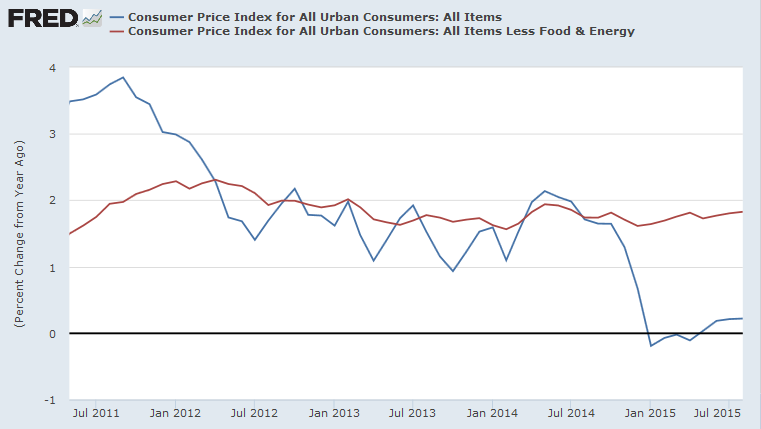
Core CPI remains subdued at 1.83 percent for the 12 months to August — close to its 2 percent target — so there is no urgency to increase rates despite a strengthening job market.
The act of revising the target rate is largely symbolic. There is no doubt that the economy can withstand an increase in the Fed Funds Rate to 0.5%. But commencement of a tightening cycle may scare an already jittery market. There is a fairly equal split amongst economists as to whether the Fed should proceed with the rate rise or not. My guess is that the Fed will opt for a bet each way, with a wider target range (say 0.00 to 0.50 percent) or a reduced increment (say 0.10 to 0.30 percent). The effective FFR is currently sitting at 0.14 percent and I am sure the Fed's plan is to continue with a gradual increase over time and no sudden movements.
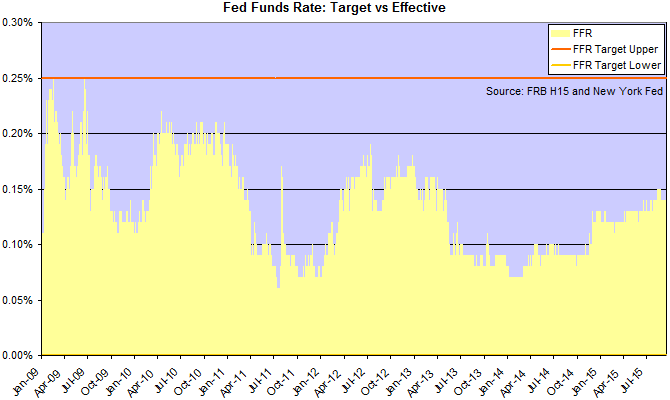
The S&P 500 is testing resistance at 2000 after a higher trough and rising 21-day Twiggs Money Flow indicate buying pressure. Recovery above 2000 would signal a relieving rally, while respect of resistance would suggest another test of support at 1900.
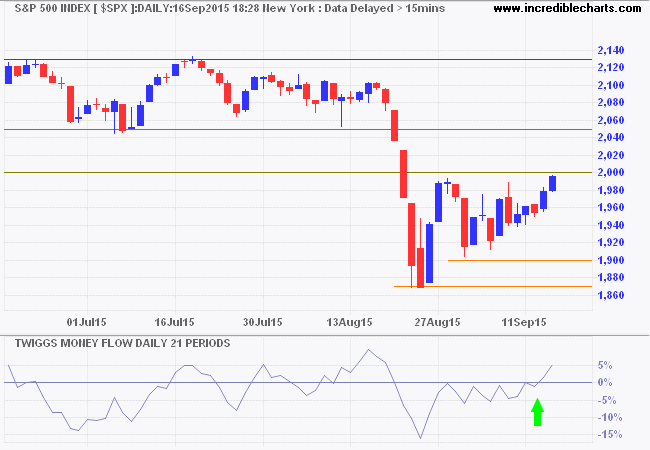
* Target calculation: 1900 - ( 2000 - 1900 ) = 1800
The CBOE Volatility Index (VIX) indicates market risk is declining.
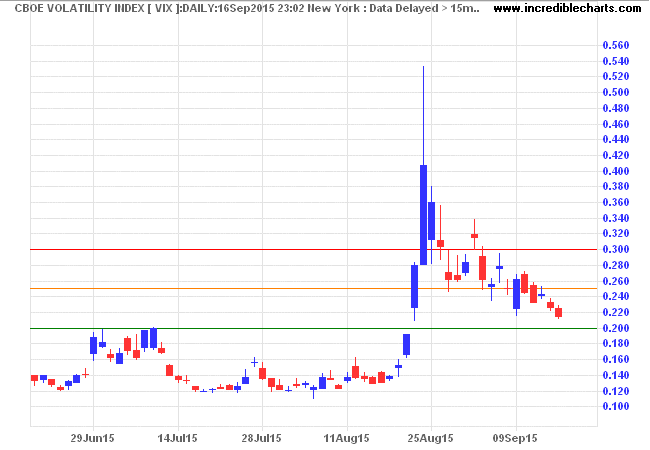
NYSE short sales are also declining.
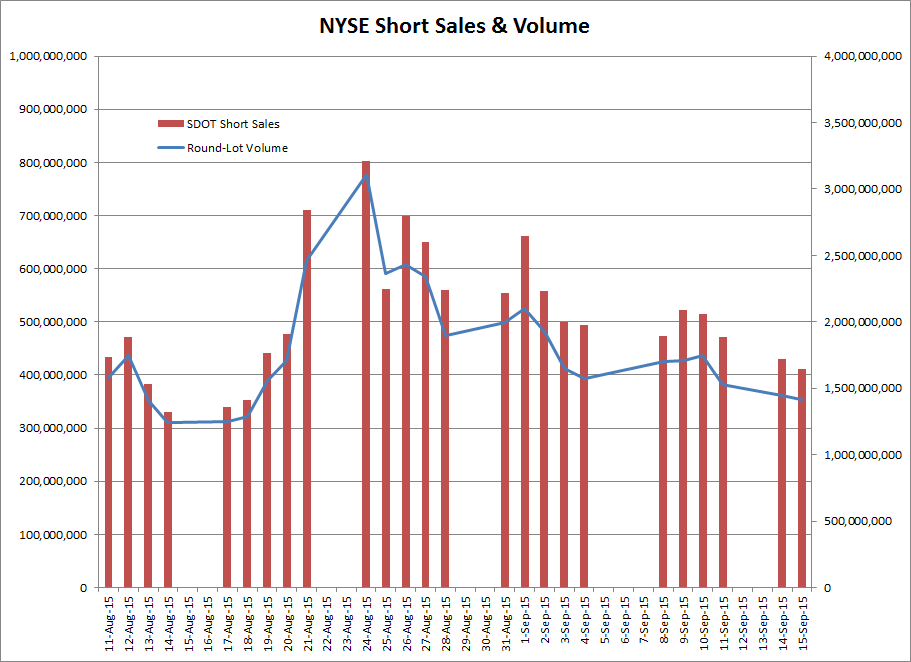
Dow Jones Industrial Average closed above resistance at 16700. Follow-through after the FOMC decision would confirm a relieving rally. Reversal below 16600 would warn of another test of 16000. Failure of support at 16000 is unlikely, but would signal a primary down-trend. Recovery of 21-day Twiggs Money Flow above zero indicates medium-term buying pressure.
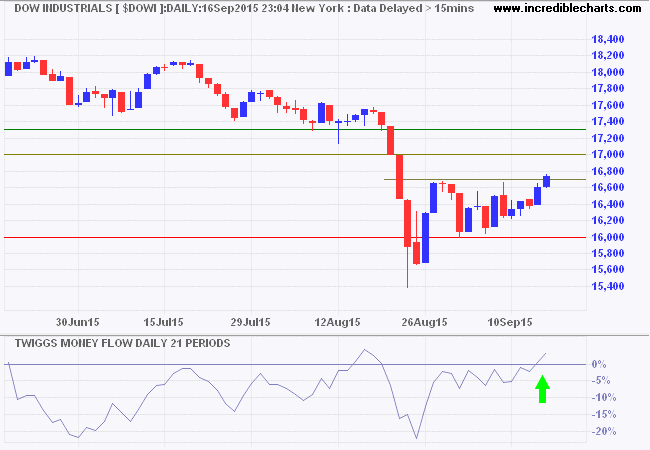
Canada's TSX 60 recovered above 800, indicating solid support between 790 and 800. Recovery above 820 and the descending channel would signal that the correction has ended. Rising 13-week Twiggs Momentum would strengthen the signal, while recovery above zero would confirm.
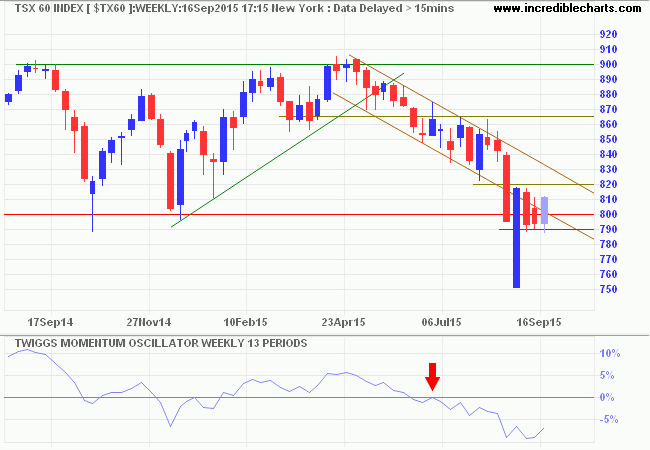
* Target calculation: 800 - ( 900 - 800 ) = 700
Europe
Germany's DAX found support at 10000. Recovery above 10500 would suggest a relieving rally, but only follow-through above the descending trendline and resistance at 11000 would confirm. Respect of the zero line by 13-week Twiggs Money Flow is a bullish sign; completion of a trough above zero would confirm long-term buying pressure.
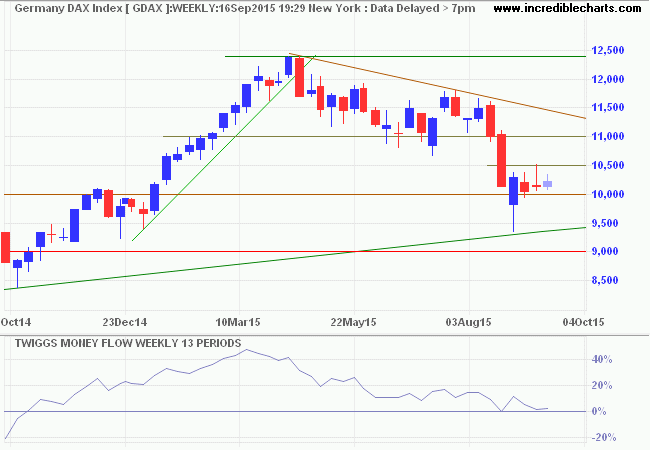
The Footsie similarly found support at 6000. Recovery above 6300 would indicate a relieving rally. Penetration of the descending trendline would confirm.
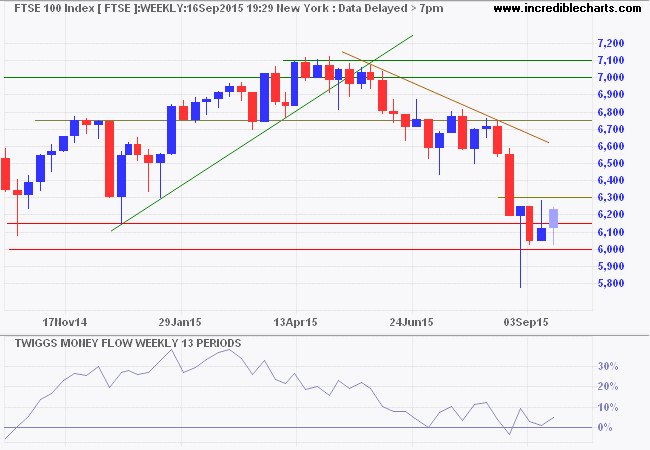
Asia
The Shanghai Composite Index continues to test (enforced) support at 3000. Recovery above 3500 is unlikely, but would indicate that the crisis has passed.
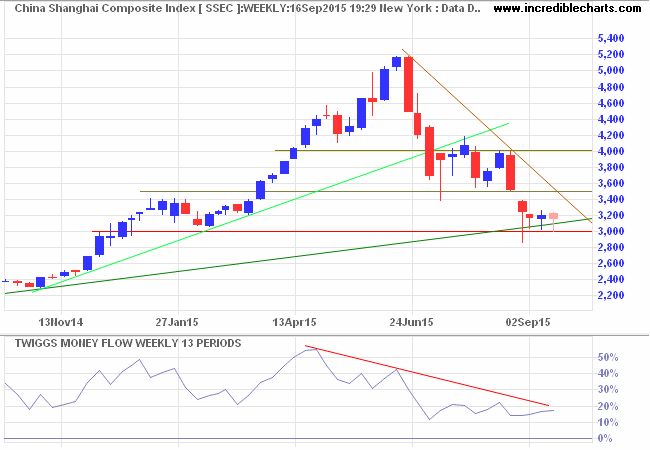
Hong Kong's Hang Seng Index found support at 21000 and is likely to test the former primary support level at 23000. 13-Week Twiggs Money Flow below zero indicates long-term selling pressure, but recovery above zero would suggest a false signal. Breakout above 23000 and the descending trendline is unlikely, but would signal that the down-trend is over.
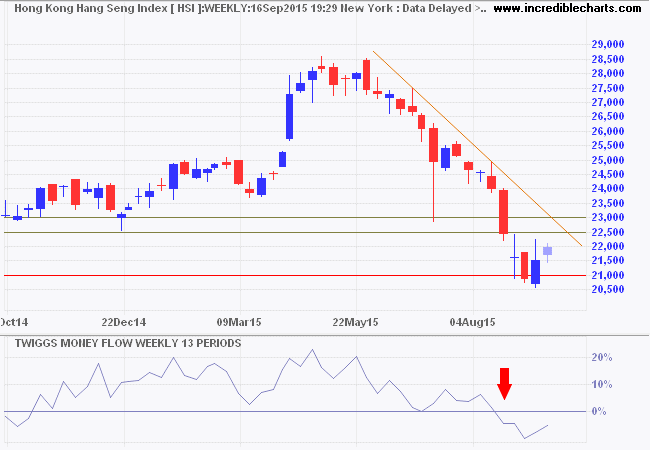
Japan's Nikkei 225 found support at 17500. Recovery above 19000 would signal a rally to test resistance at 21000. The gradual decline on 13-week Twiggs Money Flow suggests medium-term selling pressure rather than a primary (long-term) shift.
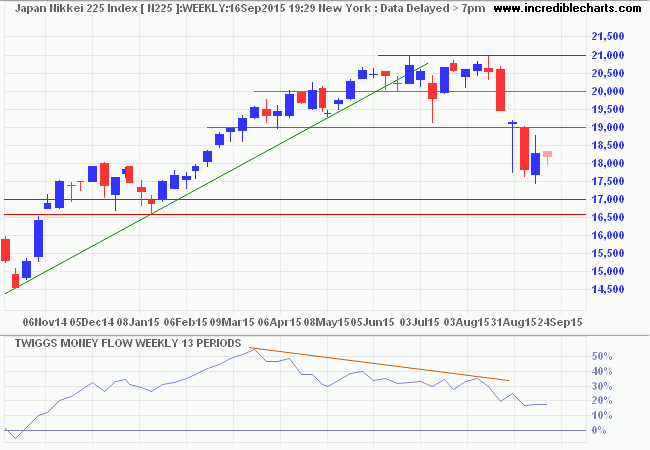
* Target calculation: 19000 + ( 19000 - 17500 ) = 20500
India's Sensex is headed for a test of the new resistance level at 26500. The primary trend is downward. Respect of the zero line by 13-week Twiggs Money Flow indicates medium-term buying pressure. Recovery above 26500 is unlikely, but would warn of a bear trap. Respect of resistance remains more likely and would suggest another decline.
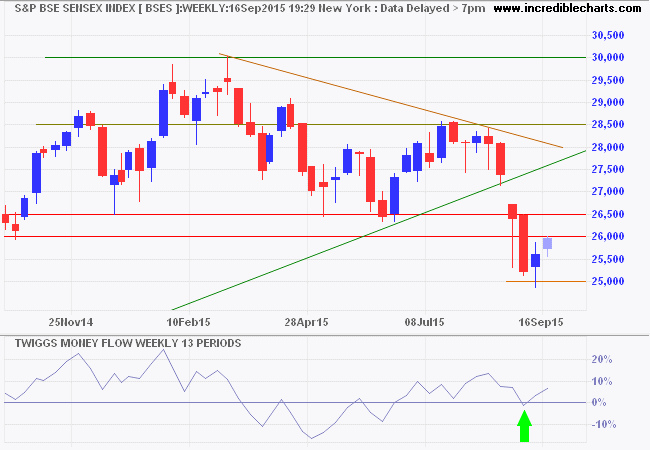
* Target calculation: 25000 - ( 26500 - 25000 ) = 23500
Australia
The ASX 200 continues to test primary support at 5000. 21-Day Twiggs Money Flow oscillating around zero indicates uncertainty. Breach of 5000 would confirm a primary down-trend. Recovery above 5300 is less likely, but would indicate a bear rally.
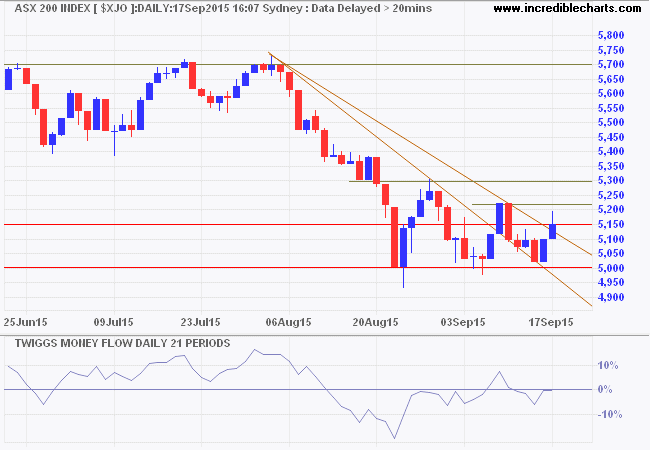
* Target calculation: 5000 - ( 5400 - 5000 ) = 4600
Just a word of caution. Relieving rallies can (and often do) fail. Probability of a continued primary up-trend will only improve once support levels have been tested. Early movers always face greater uncertainty. Which is why our long-term portfolios continue to hold high levels of cash.
You really wonder why leaders want these jobs when they really do not want to lead. And what is their risk? That Barack Obama will not get a second term? Or that Angela Merkel's coalition might finally end up on the rocks? If they actually made the leap they might astound themselves. Because, in the end, everyone in political life gets carried out — the only relevant question is whether the pallbearers will be crying.
~ Paul Keating, 24th Prime Minister of Australia (2011)
Disclaimer
Research & Investment Pty Ltd is a Corporate Authorized Representative (AR Number 384 397) of Andika Pty Ltd which holds an Australian Financial Services Licence (AFSL 297069).
The information on this web site and in the newsletters is general in nature and does not consider your personal circumstances. Please contact your professional financial adviser for advice tailored to your needs.
Research & Investment Pty Ltd ("R&I") has made every effort to ensure the reliability of the views and recommendations expressed in the reports published on its websites and newsletters. Our research is based upon information known to us or which was obtained from sources which we believe to be reliable and accurate.
No guarantee as to the capital value of investments, nor future returns are made by R&I. Neither R&I nor its employees make any representation, warranty or guarantee that the information provided is complete, accurate, current or reliable.
You are under no obligation to use these services and should always compare financial services/products to find one which best meets your personal objectives, financial situation or needs.
To the extent permitted by law, R&I and its employees, agents and authorised representatives exclude all liability for any loss or damage (including indirect, special or consequential loss or damage) arising from the use of, or reliance on, any information. If the law prohibits the exclusion of such liability, such liability shall be limited, to the extent permitted by law, to the resupply of the said information or the cost of the said resupply.
Important Warning About Simulated Results
Research & Investment (R&I) specialise in developing, testing and researching investment strategies and systems. Within the R&I web site and newsletters, you will find information about investment strategies and their performance. It is important that you understand that results from R&I research are simulated and not actual results.
No representation is made that any investor will or is likely to achieve profits or losses similar to those shown.
Simulated performance results are generally prepared with the benefit of hindsight and do not involve financial risk. No modeling can completely account for the impact of financial risk in actual investment. Account size, brokerage and slippage may also diverge from simulated results. Numerous other factors related to the markets in general or to the implementation of any specific investment system cannot be fully accounted for in the preparation of simulated performance results and may adversely affect actual investment results.
To the extent permitted by law, R&I and its employees, agents and authorised representatives exclude all liability for any loss or damage (including indirect, special or consequential loss or damage) arising from the use of, or reliance on, any information offered by R&I whether or not caused by any negligent act or omission.

Author: Colin Twiggs is a former investment banker with almost 40 years of experience in financial markets. He co-founded Incredible Charts and writes the popular Trading Diary and Patient Investor newsletters.
Using a top-down approach, Colin identifies key macro trends in the global economy before evaluating selected opportunities using a combination of fundamental and technical analysis.
Focusing on interest rates and financial market liquidity as primary drivers of the economic cycle, he warned of the 2008/2009 and 2020 bear markets well ahead of actual events.
He founded PVT Capital (AFSL No. 546090) in May 2023, which offers investment strategy and advice to wholesale clients.
